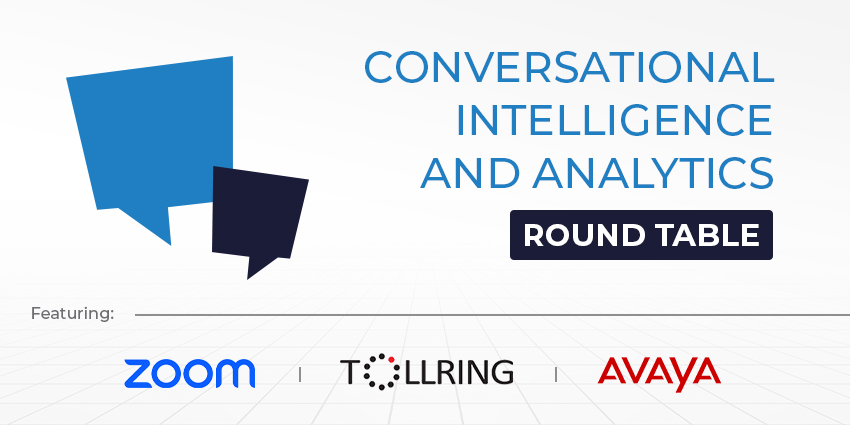In 2024, conversational intelligence and analytics in UC have become pivotal in transforming how organisations interact and collaborate, both internally between employees and managers and also with customers and clients.
Several cutting-edge trends define the space, not least the crucial role of AI and automation. However, as these technologies become more advanced, organisations are encountering challenges such as data privacy concerns and the complexities of implementation.
With our latest Round Table subject, “Conversational Intelligence and Analytics”, we spoke with experts and executives from Avaya, Zoom and Tollring about the most significant trends in conversational analytics, the key challenges organisations face in integrating conversational analytics into their systems, the role NLP plays in the development and effectiveness of conversational intelligence tools, and what the space’s future might look like in the next five-to-ten years.
What are the most significant trends in conversational analytics currently impacting organisations?

Tvrtko Stosic, Customer Engagement Consultant at Avaya
For Stosic, conversational analytics provide a great source of data about customer experiences, behaviours, and sentiment.
“Customers tell agents everything they think about a company’s products, services, marketing campaigns, policies, procedures, and the support they are receiving,” Stosic explained.
“In the past, these insights were used primarily for improving internal contact centre and customer service operations, quality management, and similar tasks. But today, companies are ‘merging’ insights derived from conversational analytics with other enterprise data, forming a comprehensive base of information on which other types of AI analytics can work—namely, predictive and prescriptive analytics.”
Stosic added that predictive analytics uses historical data to predict what will happen in the future, while prescriptive analytics makes suggestions to a company about what to do based on those predictions. “Together, those two types of AI-driven analytics enable CX personalisation on steroids—or hyper-personalisation—through proactivity and predictions,” he said.
Hilary Oliver, Chief Customer Officer at Tollring
Oliver noted that the growth of Microsoft Teams and its use as a telephony platform has propelled the need for analytics that are equivalent, if not better, than traditional phone systems.
“Business users want their conversations to have transcriptions and recordings, and this, combined with the prevalence of chat-based communication (even for externally-facing conversations), means that analytics solutions need to provide more comprehensive insights than before,” Oliver said.
“There is also a growing expectation for AI-based analytics,” Oliver continued. “This can be applied to written communication (both in chat conversations between people and with bots) and recorded verbal discussions.”
Oliver highlighted that AI-enabled analysis of Teams call recordings has been particularly in demand, allowing businesses to assess the effectiveness of their people, processes and workflows quickly without needing to listen to calls manually.
“For example, sales teams can measure whether new products have been mentioned as part of a launch KPI, and customer service teams can see sentiment ratings without needing to survey their customers,” Oliver suggested.
“Of course, AI isn’t just enabling new use cases but making existing ones much more accessible, both in terms of cost and deployment. For example, demand for call recording as part of a compliance strategy remains key for many businesses, particularly those that take payments on the phone. AI-based analytics have made it easier to prove adherence to policy, and make it faster to investigate non-conformance.”
Laura Ball, CX AI Lead for EMEA at Zoom
Ball emphasised that the advancements in Natural Language Processing (NLP) and Machine Learning (ML) are the most notable trends in conversational intelligence.
“Conversational analytics tools, for example, chatbots, are now capable of analysing conversations to extract valuable data on customer sentiment, engagement levels, and emerging topics,” Ball clarified. “These insights are increasingly being used to improve customer service, optimise sales strategies, and inform product development. Enabling organisations to respond swiftly to issues and opportunities as they arise, creating a more agile and responsive business environment.”
Ball also outlined that conversational analytics tools can help sales and marketing teams improve deal cycles, accurately forecast sales, and refine competitive strategies. “In addition, these technologies can support organisations in better understanding customer interactions, reducing manual workload, and enabling revenue growth through data-driven decision-making,” she added.
What are the primary challenges organisations face when integrating conversational analytics into their systems, and can these challenges be effectively addressed?

Laura Ball, CX AI Lead for EMEA at Zoom
Ball highlighted that ensuring the accuracy of the insights conversational analytics provide is a predominant challenge. “Initially, while AI and machine learning start with a solid base of accurate data, the technology doesn’t know everything right off the bat,” Ball explained.
“Over time, though, their accuracy improves as they learn from interactions. Initially, human oversight – from sales or customer service managers – is essential. They’ll need to monitor and correct the AI’s feedback and analysis, helping guide the technology towards greater precision.”
Ball elaborated by noting that training and onboarding can also be challenging, but platforms with conversational intelligence tech offer extensive training modules, real-time feedback, and automated coaching features to help teams quickly adapt.
“These tools enable teams to maximise the benefits of conversational analytics, leading to significantly improved productivity, as well as enhanced customer engagement and satisfaction,” Ball said.
Hilary Oliver, Chief Customer Officer at Tollring
Oliver suggested that fear and apprehension about using AI have been a major challenge, but this is gradually reducing.
“The shift to Teams means everyone is now more familiar with cloud-based collaboration tools, and when Microsoft introduced Copilot, this propelled AI at work into the mainstream,” Oliver said. “Alongside the explosion of AI in our personal lives, this has meant that it has become more familiar to people generally, with far less hesitation, fear, and resistance than before.”
“At first, deploying these technologies was a challenge, relying on bespoke deployments,” Oliver continued. “However, we are past this stage, and software vendors are now able to productise solutions to suit partners and end customers. In fact, customers are more likely to encounter conversational analytics as part of existing applications and product sets than through brand-new deployments.”
“For example, we have increased the scope of our communications analytics solutions to add transcription, sentiment, and chat analytics, which makes sense because insights should be consumed within the context of an organisation’s entire customer experience for them to make the most impact.”
Tvrtko Stosic, Customer Engagement Consultant at Avaya
Stosic noted that because conversational analytics solutions are traditionally siloed, integrating conversational analytics insights with marketing, sales, and services data available across various enterprise systems (CRMs and similar) to form an informational base for other types of AI-driven analytics is a big challenge.
“Various approaches exist to address this, usually around creating centralised data repositories or data lakes,” Stosic elaborated. “However, physical integration of data is not enough. To get meaningful results, data needs to be properly correlated, adapted, scaled, and normalised. This is done through various data science techniques. Subject-matter expertise in your company’s particular vertical is of the essence here.”
Stosic highlighted that there are new use cases coming out, too—beyond gathering post-festum insights based on large quantities of conversations.
“Today, companies are using conversational analytics in real time to influence journeys by doing the right things for customers at the right moments,” Stosic said. “For that purpose, vendors are enabling their solutions (primarily voice/chat bots and AI assists) to understand human conversations far beyond simple intent detection – and allowing them to integrate with other types of AI analytics used within enterprises.”
Stosic stressed that the challenge is that in real-time, there is only one conversation that must be analysed and meaningfully interpreted — not a bunch of them. “This means that the possibility of incorrect interpretations is much higher.,” he added. “This challenge is being addressed through advances in conversational analytics technology and growing experience in the use of the technology.”
What role does Natural Language Processing (NLP) play in the development and effectiveness of conversational intelligence tools?

Hilary Oliver, Chief Customer Officer at Tollring
Oliver stated that NLP creates personalised interactions by analysing past interactions and helping organisations understand user preferences and behaviours. It can generate rapid responses that are tailored to the specific user based on their history and preferences and ensure they are both meaningful and contextually appropriate.
“NLP applied to customer sentiment is a powerful tool when coupled with other metrics,” Oliver said. “For example, certain queries can be escalated or prioritised based on the detected sentiment, such as negative responses. Ultimately, NLP will enhance the effectiveness of conversational systems and improve the customer experience.”
Laura Ball, CX AI Lead for EMEA at Zoom
Ball argued that NLP-equipped conversational tools are pivotal for organisations aiming to improve service efficiency and strengthen their bottom line. “Chatbots equipped with NLP and Natural Language Understanding (NLU) can understand language more effectively, allowing them to engage in more natural conversations with individuals,” Ball explained.
“These chatbots can grasp both the literal meaning of words and their context, enhancing their intelligence with each interaction. This can lead to enhanced customer experiences by making interactions feel more natural and human-like.”
Ball added that NLP also powers deeper customer segmentation and sentiment analysis, offering insights into customer loyalty and potential value from past interactions. “This analysis helps agents tailor conversations to meet customers exactly where they are in their journey, refining service offerings based on previous enquiries,” Ball said.
Tvrtko Stosic, Customer Engagement Consultant at Avaya
Stosic believed that with the perspective of conversational intelligence, AI allows the humanisation of interactions with machines.
“AI enables conversational intelligence tools to understand complex intents, solve complex problems, and even mimic empathy and emotions,” Stosic said. “AI also enables faster and less work-intensive training and the fine-tuning of conversational intelligence tools through the automation of various related tasks—from the generation of intent and synthetic data to automated testing.”
Stosic also suggested that integration with other types of enterprise AI (like predictive and prescriptive analytics) enables conversational intelligence tools to propose creative and meaningful solutions to customers and agents in different situations.
“In this way, companies can ensure doing the right things for customers at the right moments of their journeys, which is the essence of superb CX,” Stosic continued.
How do you foresee the future of conversational intelligence evolving in the next 5-10 years?
Tvrtko Stosic, Customer Engagement Consultant at Avaya
Stosic and Avaya expect Multimodal AI interfaces to have a big impact. “With this evolution, traditional chatbots will evolve into a new type of UI – multimodal customer service avatars,” Stosic expanded.
“An AI avatar is a human-like virtual persona created using text-to-video generation,” he described. “Avatars will be able to process not just voice or text but also images, graphics, gestures, facial expressions, eye movements and more. Going forward, by using the proper equipment, avatars could also be able to react to our bio-sensory data. Apart from understanding multimodal input, avatars will also be able to produce multimodal output.”
Stosic explained that they will be able to express themselves in both a verbal and non-verbal fashion.
“Multimodal avatars will dramatically outperform current bots in the understanding of a customer’s intent and emotions, reducing ambiguity and offering hyper-personalisation – including the ability to empathise with a customer’s emotional state,” Stosic said.
Laura Ball, CX AI Lead for EMEA at Zoom
Ball believes NLP and NLU technologies will drive conversational intelligence’s evolution even further.
“These advancements will enable machines to comprehend language more effectively, alongside the rise of smart recording, which will become essential,” Ball said.
“By utilising NLP, smart recording can summarise and extract key information from meetings, such as actionable items and highlights, enabling users to quickly navigate to important parts of the recording. This technology will evolve to automate repetitive tasks and follow-ups, allowing users to focus on more meaningful work, such as product development and customer support.”
Ball also suggested the industry will see an increasing collaboration between AI and humans, with AI becoming more proactive in its role. “As NLU algorithms continue to draw insights from diverse sources, chatbots equipped with these technologies will be able to engage in more natural and meaningful conversations,” Ball elaborated.
“As these chatbots will understand both literal meanings and context, this will allow them to improve their intelligence with every interaction. Unlike rules-based chatbots that restrict users to predefined options, intelligent AI chatbots will process information in a human-like manner, offering more dynamic and flexible interactions.”
Hilary Oliver, Chief Customer Officer at Tollring
Oliver outlined that the future will bring relevant intelligence to everyone — they won’t need to look for it.
“One of the main benefits will be time-saving, particularly for anyone with administration responsibilities that distract them from their primary roles,” Oliver said. “Generative AI will be a game changer, offering unprecedented opportunities for growth, efficiency and innovation. It will extend analytics and make the information delivered faster, more powerful, and more relevant, delivering useful insights rather than just presenting the data.”
Oliver, however, caveated that human interaction will continue to be the basis for the best customer experience for some time.
“With the right information at their fingertips at the right time, agents will be able to deal with each customer more effectively, drawing on accurate information and delivering their specific expertise or services to meet the customer’s needs with empathy,” she concluded. “While AI might seek to replicate empathy and even deliver it via a bot, a lack of authenticity will only undermine this approach.”







